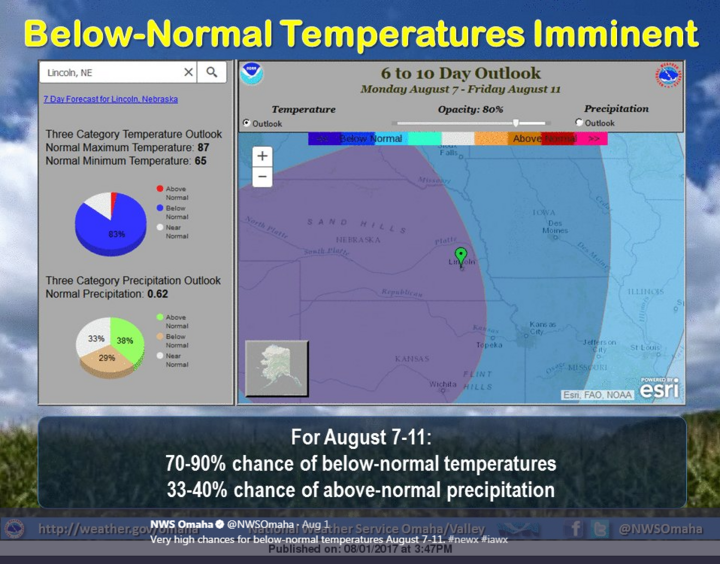Considering the day to day and week to week variability in weather we’ve experienced and the wide range of regional conditions across Nebraska this year, scouting fields for kernel set and overall condition may be more important than ever.
Nevertheless, some measures of the 2017 corn crop are similar to previous years. For instance, according to USDA-NASS, as of July 30, 91% of Nebraska’s corn crop was silking — similar to last year’s 93% and the five-year average of 90%. In addition, the U.S. Drought monitor as of August 1 indicates that — similar to last week — 86% of Nebraska is abnormally dry. Meanwhile, on the positive side, Al Dutcher in last week’s CropWatch suggested that precipitation may ease dry conditions in the western third of the state. This occurred to some extent but the eastern half of the state may see a further deterioration in conditions.
There is more good news: Recent cool temperatures and the forecast for below-normal temperatures August 7-11 bode well for the early phases of corn kernel fill. Cool conditions during grain fill provide a great ingredient for higher yields!

Here’s a brief summary of corn conditions by region:
Panhandle
The majority of corn in the Panhandle has tasseled and pollination is underway. Irrigated corn producers should evaluate the fertility level of their corn crop through tissue and/or soil sampling and make their last nitrogen application through their irrigation system.
Dryland corn producers in the Panhandle can only wait and see what comes at corn harvest. Corn planted on-time looks really good and producers should expect average to above average yields. Corn will not readily take up nitrogen applications at this time of year due to a lack of precipitation and this practice is not advisable.
Southwest Nebraska
Well-managed irrigated corn in southwest Nebraska is progressing well and looking really good. The big task for our producers now is to make sure their crops are well-irrigated (see Predicting Late-Season Irrigation Needs). Irrigated corn producers should evaluate the fertility level of their corn crop through tissue and/or soil sampling and make their last nitrogen application through their irrigation system.
Crop dusters were flying non-stop the past three weeks delivering fungicides/insecticides.
Dryland corn fields in parts of southwest Nebraska have been stressed because of the dry conditions we had during the past several weeks. Recent rains will help the crop; however, dry conditions have likely hurt yield potential.
South-Central Nebraska
Corn in this area has progressed rapidly after the high heat in spite of cooler conditions this past week. Corn is in the early milk to near dough stages. For the most part there appears to be decent ear fill. Conditions do exist field to field with aborted kernels due to any number of factors including high heat and rootworm beetle and/or grasshopper silk clipping. Growers are also seeing a lot of double ears this year across companies. Non-irrigated corn in portions of the area are really showing drought stress with varying ear development and pollination, depending on tillage and rainfall conditions. Nearby areas, particularly areas of Seward County, have very good non-irrigated corn.
East-Central Nebraska
Over the past week two leaf fungal disease have become much more noticeable in corn and may warrant fungicide application: gray leaf spot and southern rust. Scout fields to determine disease presence and control options. (For more see Extension Educator Nathan Mueller’s most recent blog.)
Summary
Scouting for pests and kernel set should remain a priority. Control methods should be used once pest levels surpass damage thresholds.

